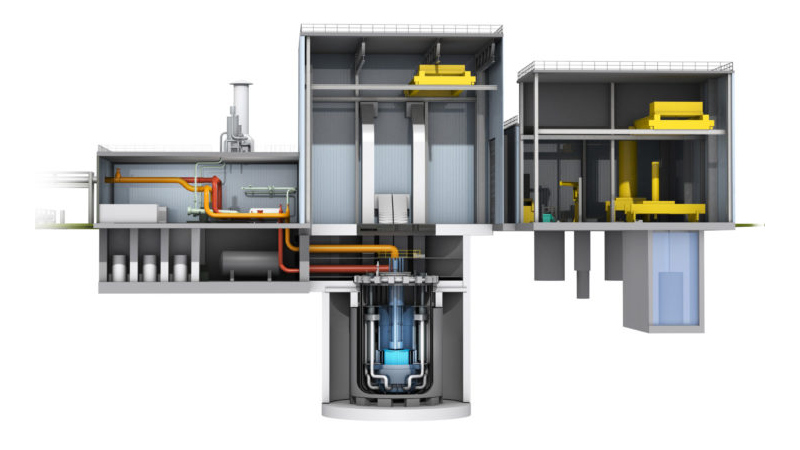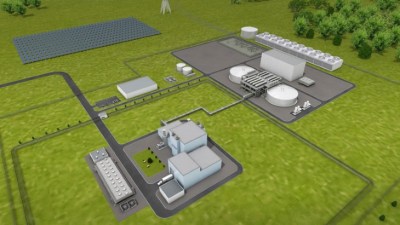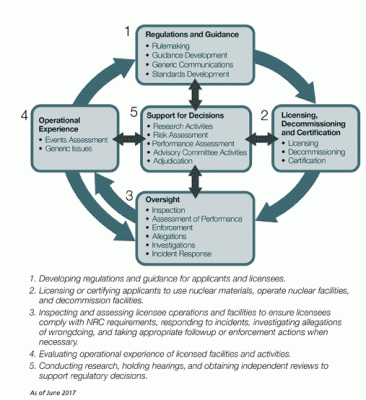
Most new nuclear fission reactors being built today are of the light water reactor (LWR) type, which use water for neutron moderation into thermal neutrons as well as neutron capture. While straightforward and in use since the 1950s in commercial settings, they are also essentially limited to uranium (U-235) fuel. This is where fast neutron reactors are highly attractive.
Fast neutron reactors can also fission other fissile elements, covering the full spectrum of neutron cross sections. TerraPower’s Natrium reactor is one such fast reactor, and it’s the world’s first fast reactor that not only targets commercial use, but also comes with its own grid-level storage in the form of a molten salt reservoir.
The upshot of this is that not only can these Natrium reactors use all of the spent LWR fuel in the US and elsewhere as their fuel, but they should also be highly efficient at load-following, traditionally a weak spot of thermal plants.
TerraPower and its partners are currently looking to build a demonstration plant in Wyoming, at the site of a retiring coal plant. This would be a 345 MWe (peak 500 MWe) reactor.
Why Natrium is Exciting

As mentioned in the introduction, the Natrium reactor can use not just U-235 as its fuel. This is a property of the neutrons used in the reactor. As a refresher, the water used in current commercial fission reactors acts as a moderator on the neutrons that are produced during a nuclear fission chain reaction, effectively slowing them down. This makes the resulting thermal (‘slow’) neutrons fall right within the neutron cross section for U-235 and a few other elements (e.g. Pu isotopes), but incapable of fissioning most transuranics and actinides.
Over time the build-up of those transuranic and actinide isotopes ‘pollute’ the fuel in an LWR to the point where the nuclear chain reaction is far less efficient than with ‘fresh’ fuel rods. This is the point where an LWR is refueled (generally on a 2-year cycle), and the spent fuel rods are stored or reprocessed. In the latter case the problematic isotopes are removed via chemical processes as a lot of U-235 fuel remains in these fuel rods.
Since Natrium uses sodium as its coolant instead of water (the reason behind its name), it can use fast neutrons as well as thermal neutrons. As a result any isotope in the fuel that’s fissile can become part of the nuclear chain reaction, allowing this reaction to proceed until no further fissile elements remain in the fuel. This includes the U-238 that makes up a large percentage of uranium fuel.
Natrium reactors could thus run on the spent fuel stored in cooling pools at LWRs around the country and only produce small amounts of short-lived waste. This is essentially the culmination of decades of research in US test reactors like the EBR-II and FFTF and similar in scope to Russia’s BN-series of fast reactors. TerraPower has teamed up with Centrus for the production of the High-Assay, Low-Enriched Uranium (HALEU) fuel for the Natrium reactor.
In addition to these reactor designs, Natrium also adds an on-site energy storage in the form of molten salt that can bump up the reactor’s electrical output from 345 MWe to 500 MWe for about 5.5 hours. This would make it possible to flexibly cover peaks in demand.
Still a Long Road Ahead

Before anyone is allowed to build or operate a nuclear plant in the US it has to go through the Nuclear Regulatory Commission (NRC). A panel of experts will analyze, comment on, and require changes to offered designs until they are confident that that all regulations are adhered to and all relevant questions answered. I covered this process in detail previously.
For TerraPower’s Natrium this certification process can be followed via its public page. This tells us that Natrium is currently in the pre-application stage. Once the application has been finalized and submitted, Phase 1 of the Safety Evaluation Report (SER) can commence, which will then go through another few phases before resulting in the final SER (FSER), which will be used for the rulemaking, at which point the Natrium design will be allowed for new construction in the US.
With that approval in hand, the NRC would still have to approve the construction of each individual Natrium reactor, involving more safety reports, and in order to also be allowed to turn the reactor on and operate it commercially, even more safety reviews and reports would be involved. This makes the claim by TerraPower (on e.g. their Fact Sheet) of the Natrium design being available for commercial use (i.e. construction of new plants) by the late 2020s seem believable.
Cue the Competition

Perhaps most telling is that TerraPower isn’t the sole company seeking to commercialize a fast neutron reactor. In Russia, Rosatom along with nuclear fuel manufacturer TVEL have announced the start of construction of the BREST-OD-300 lead-cooled reactor. Like the Natrium design, this is a Generation IV fast neutron reactor, but it uses lead as coolant instead of sodium, which is beneficial in terms of heat transfer capacity as it has a higher melting point than sodium.
BREST-OD-300 is designed to have on-site fuel processing capacity, to keep a closed uranium fuel cycle within the plant’s grounds. Alongside this reactor type, Rosatom is also looking to build a number of sodium-cooled BN-1200 fast reactors which build upon the research done with the BN-350, BN-600, and BN-800 reactors since the 1970s. So far, two BN-1200s are scheduled for construction in Russia.
In China, the CFR-600 has been under construction since 2017. Much like in Russia, the idea is to run these fast reactors alongside LWRs in a complementary manner. Meanwhile in India, its PFBR is scheduled to be put online by 2021, when it will be used primarily to transmute (breed) U-233 from thorium as part of India’s thorium-based fuel cycle.
It’s clear that the demand for commercial fast reactors exists, and that TerraPower’s Natrium reactor might be the US’s best bet to be a part of this market.
Adding Grid Level Storage
Where TerraPower’s Natrium reactor is different from the competition is that it focuses not so much on the traditional role of thermal plants which involves getting as much steam or equivalent to a turbine to generate electricity. Instead, the heat from the reactor’s core is led away using the sodium coolant and stored in multiple large, insulated tanks. This is similar to how Concentrated Solar Power (CSP) with thermal storage works.

This stored heat energy can then be used as needed to spin an electric generator, heat buildings, and so on. By decoupling the processes of generating the thermal energy and using it for generating electricity and so on, the electrical output of such a nuclear plant can be varied dynamically depending on the needs of the grid. This leads TerraPower to advertise Natrium as the ideal firm power compliment to a grid with a lot of variable renewable energy (VRE) like solar and wind.
Currently VRE-heavy grids rely on simple-cycle combustion turbines (SCCT) which have no waste heat recovery. While a lot faster to spin up and down than combined cycle turbines (CCGT), a CCGT plant will have a thermal efficiency of over 60%, whereas a simple-cycle plant will be generally just over 30%, with worse efficiencies while idling, such as when they are standing by to cover surges in demand.
The Broader Picture
The world today grapples with the realization that the sooner we rid ourselves of fossil fuels, the better off we’ll be. Yet right now the overwhelming majority of our daily energy use for transport (even with electric vehicles) and such still comes from fossil sources. In US states like California, natural gas makes up the overwhelming majority of its in-state sources of electricity using its over 200 natural gas plants. These are a combination of SCCT and CCGT plants.
With the rapid increase in the deployment of VRE, it’s important to provide grid-level storage and peaker plants which can respond rapidly to both the naturally fluctuating demand for power, as well as the variable input from these VRE sources. This is one area where something like TerraPower’s Natrium design may make a lot of sense, especially considering that it removes the ‘nuclear waste’ argument that is often used against new nuclear.
Regardless of how things play out in the USA, it seems clear that many countries are ready to embrace fast neutron reactors for commercial purposes. It still remains to be seen whether TerraPower’s concept of thermal storage in combination with a nuclear plant will stick, however. It too trades some thermal efficiency for convenience, which may or may not be worth it in the long run and might be better covered by e.g. battery storage alongside a traditional thermal plant design.
0 Commentaires